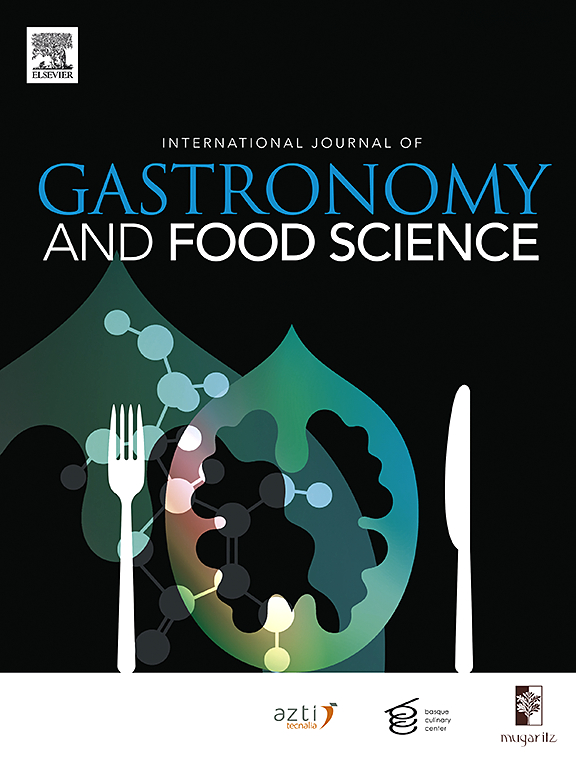使用黄原胶的三维打印蛋糕糊的特性以及利用响应面方法优化打印参数
IF 3.2
2区 农林科学
Q2 FOOD SCIENCE & TECHNOLOGY
International Journal of Gastronomy and Food Science
Pub Date : 2024-09-26
DOI:10.1016/j.ijgfs.2024.101026
引用次数: 0
摘要
增材制造(也称三维打印)为食品工业提供了大量创新的加工技术。这种技术能够快速生产复杂的物体,而不会受到复杂设计的阻碍,让设计师们可以无拘无束地探索新颖的几何形状,而无需模具。亲水胶体是一种亲水性化合物,可用作增稠剂或胶凝剂,在改变食品体系特性和增强印刷过程中的机械稳定性方面发挥着关键作用。在一项以蛋糕面糊为重点的研究中,黄原胶以不同的比例(0.5%、1%、1.5% 和 2%)加入,以评估印刷适性并优化印刷参数。研究结果表明,添加黄原胶后,印刷适性得到了显著改善,确保了整个印刷过程中的结构完整性。值得注意的是,黄原胶含量较高的蛋糕,由于粘度增加,挤压效果较差,形状不规则;而黄原胶含量较低的蛋糕,流动性增强,但形状精度受到影响。使用 1%的黄原胶可以获得最佳效果,其动态粘弹性能表明,黄原胶具有优异的流动性和机械强度。进一步的分析表明,特定的打印参数,包括喷嘴直径(1.24 毫米)、打印压力(3.3 巴)和喷嘴移动速度(33.55 毫米/秒),产生了最佳效果,打印出的三维物体形状精确,尺寸和重量变化极小。这些发现强调了增材制造在通过精细的材料处理和参数优化彻底改变食品生产工艺方面的潜力。本文章由计算机程序翻译,如有差异,请以英文原文为准。
Characterisation of 3D printing cake batter with xanthan gum and optimization of printing parameters using response surface methodology
Additive manufacturing, also referred to as three-dimensional printing, offers the food industry a plethora of innovative processing techniques. This technology enables the rapid production of complex objects without being hindered by design intricacies, granting designers unparalleled freedom to explore novel geometric forms sans molds. Hydrocolloids, hydrophilic compounds serving as thickening or gelling agents, play a pivotal role in altering food system properties and enhancing mechanical stability during printing. In a study focused on cake batter, xanthan gum was incorporated at varying proportions (0.5%, 1%, 1.5%, and 2%) to assess printability and optimize printing parameters. Findings demonstrated a significant improvement in printability with the addition of xanthan gum, ensuring structural integrity throughout the printing process. Notably, cakes with higher xanthan gum content exhibited poorer extrusion and shape irregularities due to increased viscosity, while lower content resulted in enhanced fluidity but compromised shape accuracy. Optimal results were observed with 1% xanthan gum, showcasing superior flowability and mechanical strength, as indicated by dynamic viscoelastic properties. Further analysis revealed that specific printing parameters, including nozzle diameter (1.24 mm), printing pressure (3.3 bar), and nozzle movement speed (33.55 mm/s), yielded the best results, producing accurately shaped 3D printed objects with minimal variations in dimensions and weight. These findings underscore the potential of additive manufacturing in revolutionizing food production processes through meticulous material manipulation and parameter optimization.
求助全文
通过发布文献求助,成功后即可免费获取论文全文。
去求助
来源期刊

International Journal of Gastronomy and Food Science
Social Sciences-Cultural Studies
CiteScore
5.30
自引率
10.50%
发文量
170
审稿时长
45 days
期刊介绍:
International Journal of Gastronomy and Food Science is a peer-reviewed journal that explicitly focuses on the interface of food science and gastronomy. Articles focusing only on food science will not be considered. This journal equally encourages both scientists and chefs to publish original scientific papers, review articles and original culinary works. We seek articles with clear evidence of this interaction. From a scientific perspective, this publication aims to become the home for research from the whole community of food science and gastronomy.
IJGFS explores all aspects related to the growing field of the interaction of gastronomy and food science, in areas such as food chemistry, food technology and culinary techniques, food microbiology, genetics, sensory science, neuroscience, psychology, culinary concepts, culinary trends, and gastronomic experience (all the elements that contribute to the appreciation and enjoyment of the meal. Also relevant is research on science-based educational programs in gastronomy, anthropology, gastronomic history and food sociology. All these areas of knowledge are crucial to gastronomy, as they contribute to a better understanding of this broad term and its practical implications for science and society.
 求助内容:
求助内容: 应助结果提醒方式:
应助结果提醒方式:


